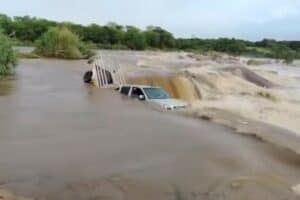If you stick to a few basic rules, you'll stay safe and preserve the environment.

It’s already month three of our time with the Ford Ranger XLT. And we are racking up the miles all over the place.
One thing South Africa offers is some beautiful outdoor escapes and some rugged terrain thrown in for good measure. This country is a paradise for off-road enthusiasts. And the Ranger bakkie is built to go off-road.
Proper off-road driving, not dirt road and game reserve stuff, demands not only a capable vehicle like the Ford Ranger. But it also requires that you have some skill, are prepared, and that you respect the nature around you.
So, whether you’re joining a local 4×4 club for a weekend trail or planning an extended overland expedition, understanding the fundamentals of off-road driving is crucial to ensuring safety, preserving the environment and maximising enjoyment. The Citizen Motoring has compiled an easy list of things you need to know to make the most out of your bakkie.
Understanding your Ford Ranger
The foundation for off-roading starts with knowing your vehicle’s capabilities and limitations. Familiarise yourself with your vehicle’s 4×4 drive capabilities (4H, 4L), diff locks, traction control systems, ground clearance, as well as approach and departure angles.
The Ford Ranger has an impressive front approach angle of 30 degrees and rear departure angle of 25.6 degrees – the latter is 23 degrees when a towbar is fitted. Certain models, such as Tremor, Wildtrak and Platinum offer an on-demand four-wheel drive system. This system offers 2H, 4A, 4H, and 4L. Modern 4x4s often come equipped with advanced Terrain Management Systems, and for Ford Ranger this comprises Normal, Eco, Tow/Haul, Slippery, Mud/Ruts, Sand and Rock Crawl modes.
The Ford Ranger XL, XLT and Wildtrak feature an electronic rear-differential lock. The Ford Ranger Raptor is equipped with a front and rear differential lock for extra traction.
Reading the terrain
Learning to “read” the terrain ahead, whether it’s assessing how deep a mud patch is or how loose gravel might affect grip, can be the difference between a successful climb and getting stuck. Certain Ford Ranger models are equipped with the off-road SYNC screen with a 360-degree camera system that makes manoeuvring in tight spaces an absolute cinch.
Also available on certain Ford Ranger models is the new Trail Turn Assist feature. This system applies the brakes to the inside wheel when negotiating tight bends in off-road conditions below 19km/h. Reducing the vehicle’s turning radius by up to 25% to help navigate around obstacles.
Throttle control and momentum
Gentle, steady throttle control is essential. The golden rule of 4x4ing safely is tackling challenges or obstacles “as slow as possible, and as fast as necessary”. In many cases, too much power can cause wheels to spin and lose traction.
Understanding when to use momentum such as driving in sand dunes and when to take it slow such as descending a rocky slope is the key to safe and efficient driving. Here certain Ford Ranger models offer Hill Descent Control and selectable driving modes to easily facilitate such tasks.
Know how to recover your Ford Ranger
Even the most skilled drivers can get stuck. Basic recovery skills and equipment are essential. These includes knowing how to use a recovery strap, and where to find your recovery points.
Every Ford Ranger has a recovery point, and certain models have dual recovery points. Never go off-roading alone; having another vehicle nearby can be a lifeline in tricky situations.
ALSO READ: Easy-going Ford Ranger XLT the perfect camping companion
Top tips for a safe and enjoyable off-road experience
Before you hit the trails, here are some essential tips to help you stay safe, protect the environment and make the most of your journey.
- Tyre pressure matters: Adjusting your tyre pressure can significantly improve traction. Lowering it slightly when driving on sand or rocky surfaces increases the tyre’s contact patch, enhancing grip. Just remember to inflate them again before returning to the road.
- Pack smart: Always carry basic recovery gear (snatch strap, shackles, spade), a first-aid kit, air compressor, and enough water and food. A GPS, maps and a reliable communication device (like a satellite phone or two-way radio) are also highly recommended, especially in remote areas.
- Tread lightly: Respect the environment. Stay on designated trails to avoid damaging sensitive ecosystems and always leave a place as you found it.
- Join a community: Off-road clubs, like the Ford Adventure Club and forums are great places to learn, share experiences and find adventure companions.
They also host regular training days and events to help drivers improve their skills in a safe and supportive environment.
ALSO READ: Even without a fancy badge, Ford Ranger XLT is a lot of bakkie
Ford adventure club
For customers purchasing new Ford 4×4 vehicles, the Ford Adventure Club offers complimentary level 1 training. This course is included as part of the vehicle purchase and is valid for 12 months from the date of purchase.
The training is specifically designed for owners of Ford Ranger and Ford Everest 4×4 vehicles, as well as the Raptor.






